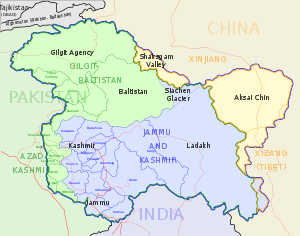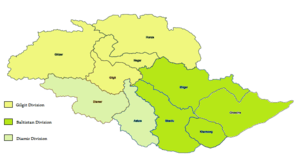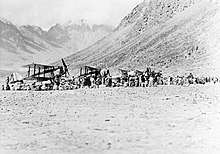Gilgit Agency
| Gilgit Agency Sargin Gleet | |||||
| Agency | |||||
| |||||
 | |||||
| History | |||||
| • | British Political agent | 1889 | |||
| • | Gilgit Wazarat leased | 26 March 1935 | |||
| • | Lease terminated | 30 July 1947 | |||
| • | Gilgit rebellion | 1 November 1947 | |||
| • | Pakistani Political agent | 19 November 1947 | |||
| • | Merged into Northern Areas | 1970 | |||
| "A collection of treaties, engagements, and sunnuds relating to India and neighbouring countries" | |||||
The Gilgit Agency (Urdu: گلگت ایجنسی) was a system of administration established by British Indian Empire over the subsidiary states of Jammu and Kashmir at its northern periphery, mainly with the objective of strengthening these territories against Russian encroachment.
An Officer on Special Duty was established in 1877 in the town of Gilgit, upgraded to a permanent Political Agent in 1889. In 1935, the Gilgit wazarat was leased from the Maharaja of Jammu and Kashmir, which also came under the administration of the Political Agent. In July 1947, shortly before the independence of India and Pakistan, these areas were returned to the Maharaja. However, the Gilgit Scouts rebelled on 1 November 1947 after the accession of Jammu and Kashmir to India, and Pakistan took over the administration of the areas soon thereafter.[1][2]
The Gilgit Agency remained in existence under Pakistani control till about 1974, when it was abolished by the Pakistani Prime Minister Zulfiqar Ali Bhutto.[3]
Area and borders

The areas under the Gilgit Agency consisted of
- the state of Chilas and the territories of Darel & Tangir (present day Diamer District)
- Punial, Yasin, Kuh-Ghizar, and Ishkoman regions (present day Ghizer District)
- the states of Hunza and Nagar (present day Hunza and Nagar districts).
All these states had their own rulers or systems of administraion; the Agency provided supervision.[4][5]
The present day Gilgit and Astore districts comprised the Gilgit wazarat of Jammu and Kashmir with its own governor (wazir-e-wazarat). However, the Political Agent did exercise some control over its affairs, leading to a system of 'dyarchy' until 1935. Afterwards the British leased the Gilgit wazarat from Jammu and Kashmir, and it came under the direct administration of the Political Agent.[4][5]
In 1941, the Gilgit Agency had a population of 77,000 and the leased Gilgit wazarat had 23,000. Both the areas together came to be loosely referred to as the 'Gilgit Agency'. The administration of the Agency was carried out "on behalf of His Highness’ Government". The Political Agent communicated with the central government in New Delhi via Peshawar (the capital of the North-West Frontier Province) for reasons of security.[6]
The administered area was bounded in the west by the Chitral State, in the northwest by Afghanistan's Wakhan corridor, in the east by Chinese Turkestan and in the southeast by the Ladakh–Baltistan wazarat of Jammu and Kashmir.
Background
| Princely state |
|---|
| Individual residencies |
| Agencies |
|
| Lists |
The Treaty of Amritsar (1846) granted to Raja Gulab Singh all the Sikh territories between the Ravi and the Indus. In the north, these territories includedGilgit (the present Gilgit District), Astore (the present Astore District) and Chilas (presently a tehsil of the Diamir District).[7] By 1860, the three areas were constituted as a Gilgit wazarat (district), and the princely states of Hunza and Nagar to the northeast accepted the suzerainty of the Maharaja Ranbir Singh.[8]
The Treaty of Amritsar did not constrain the Maharaja from establishing relationships with external powers, and he is said to have had dealings with Russia, Afghanistan and Chinese Turkestan. The British watched these developments with concern, especially in the light of Russian expansion in the north.[9]
Establishment of the Agency

Ranbir Singh's successor Pratap Singh was a weak ruler. The British used the opportunity to establish an Agency in Gilgit in 1889, stationing a Political Agent who reported to the British Resident in Srinagar. The initial purpose of the Agency was to keep watch on the frontier and to restrain Hunza and Nagar from dealing with the Russians. Soon afterwards, the states of Hunza and Nagar were brought under the direct purview of the Gilgit Agency. The Jammu and Kashmir State Forces were stationed in a garrison at Gilgit, which were used by the Agency to keep order. They were replaced by a British-officered Gilgit Scouts in 1913.[10]
Gradually, the princely states to the west of Gilgit (Punial, Yasin, Kuh-Ghizar, Ishkoman and Chitral) were also brought under the purview of the Gilgit Agency. These areas were nominally under the suzerainty of Kashmir but were directly administered by the Agency.[11] Following a rebellion 1892, Chitral was transferred to the Malakand Agency in the Frontier Areas.[12] The remaining areas remained under the control of the Gilgit Agency, which administered them through governors.[11]
Inside Pakistan
The local rulers of these territories continued to appear at the Jammu and Kashmir Durbars until 1947. The events of independence and the subsequent invasion of Jammu and Kashmir by Pakistani tribals during the First Kashmir War led to most of the former Gilgit Wazarat becoming part of Pakistan-administered Kashmir, but most of the Ladakh Wazarat, including the Kargil area, became part of Indian-administered Kashmir. The Line of Control established at the end of the war is the current de facto border of India and Pakistan.
Initially, the Gilgit Agency was not absorbed into any of the provinces of West Pakistan, but was ruled directly by political agents of the federal government of Pakistan. In 1963, Pakistan entered into a treaty with China to transfer part of the Gilgit Agency to China, (the Trans-Karakoram Tract), with the proviso that the settlement was subject to the final solution of the Kashmir dispute.
The dissolution of the province of West Pakistan in 1970 was accompanied by change of the name of the Gilgit Agency to the Northern Areas. In 1974, the states of Hunza and Nagar and the independent valleys of Darel-Tangir, which had been de facto dependencies of Pakistan, were also incorporated into the Northern Areas.
Pakistan and India continue to dispute the sovereignty of the territories that had comprised the Gilgit Agency.
See also
References
- ↑ Snedden, Understanding Kashmir and Kashmiris 2015.
- ↑ Bangash, Three Forgotten Accesions 2010.
- ↑ Ali, Nosheen K. (2005), Seeing through the state: representation and rule in the northern areas of Pakistan, Cornell University, p. 14
- 1 2 Snedden, Understanding Kashmir and Kashmiris 2015, Appendix V.
- 1 2 Bangash, Three Forgotten Accesions 2010, p. 122.
- ↑ Snedden, Understanding Kashmir and Kashmiris 2015, p. 118.
- ↑ Schofield, Kashmir in Conflict 2003, p. 20.
- ↑ Schofield, Kashmir in Conflict 2003, p. 11.
- ↑ Schofield, Kashmir in Conflict 2003, p. 12.
- ↑ Schofield, Kashmir in Conflict 2003, pp. 12–13.
- 1 2 Chohan, Gilgit Agency 1997, p. 203.
- ↑ Snedden, Understanding Kashmir and Kashmiris 2015, p. 110.
Bibliography
- Bangash, Yaqoob Khan (2010), "Three Forgotten Accessions: Gilgit, Hunza and Nagar", The Journal of Imperial and Commonwealth History, 38 (1): 117–143, doi:10.1080/03086530903538269, (Subscription required (help))
- Chohan, Amar Singh (1997), Gilgit Agency 1877–1935, Second Reprint, Atlantic Publishers & Dist, ISBN 978-81-7156-146-9
- Schofield, Victoria (2003) [First published in 2000], Kashmir in Conflict, London and New York: I. B. Taurus & Co, ISBN 1-86064-898-3
- Snedden, Christopher (2015), Understanding Kashmir and Kashmiris, Oxford University Press, ISBN 978-1-84904-342-7
External links
- Jammu and Kashmir Official Website
- Northern Areas Official Website
- Northern Areas Census (1998)
- Northern Areas Administration
- Northern Areas Map